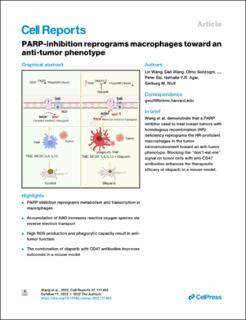| dc.contributor.author | Wang, Lin | |
| dc.contributor.author | Wang, Dan | |
| dc.contributor.author | Sonzogni, Olmo | |
| dc.contributor.author | Ke, Shizhong | |
| dc.contributor.author | Wang, Qi | |
| dc.contributor.author | Thavamani, Abhishek | |
| dc.contributor.author | Batalini, Felipe | |
| dc.contributor.author | Stopka, Sylwia A. | |
| dc.contributor.author | Regan, Michael S. | |
| dc.contributor.author | Vandal, Steven | |
| dc.contributor.author | Tian, Shengya | |
| dc.contributor.author | Pinto, Jocelin | |
| dc.contributor.author | Cyr, Andrew M. | |
| dc.contributor.author | Bret-Mounet, Vanessa C. | |
| dc.contributor.author | Baquer, Gerard | |
| dc.contributor.author | Eikesdal, Hans Petter | |
| dc.contributor.author | Yuan, Min | |
| dc.contributor.author | Asara, John M. | |
| dc.contributor.author | Heng, Yujing J. | |
| dc.contributor.author | Bai, Peter | |
| dc.contributor.author | Agar, Nathalie Y.R. | |
| dc.contributor.author | Wulf, Gerburg M. | |
| dc.date.accessioned | 2023-01-11T10:25:40Z | |
| dc.date.available | 2023-01-11T10:25:40Z | |
| dc.date.created | 2022-10-31T11:36:30Z | |
| dc.date.issued | 2022 | |
| dc.identifier.issn | 2211-1247 | |
| dc.identifier.uri | https://hdl.handle.net/11250/3042647 | |
| dc.description.abstract | Poly(ADP)ribosylation inhibitors (PARPis) are toxic to cancer cells with homologous recombination (HR) deficiency but not to HR-proficient cells in the tumor microenvironment (TME), including tumor-associated macrophages (TAMs). As TAMs can promote or inhibit tumor growth, we set out to examine the effects of PARP inhibition on TAMs in BRCA1-related breast cancer (BC). The PARPi olaparib causes reprogramming of TAMs toward higher cytotoxicity and phagocytosis. A PARPi-related surge in NAD+ increases glycolysis, blunts oxidative phosphorylation, and induces reverse mitochondrial electron transport (RET) with an increase in reactive oxygen species (ROS) and transcriptional reprogramming. This reprogramming occurs in the absence or presence of PARP1 or PARP2 and is partially recapitulated by addition of NAD derivative methyl-nicotinamide (MNA). In vivo and ex vivo, the effect of olaparib on TAMs contributes to the anti-tumor efficacy of the PARPi. In vivo blockade of the “don’t-eat-me signal” with CD47 antibodies in combination with olaparib improves outcomes in a BRCA1-related BC model. | en_US |
| dc.language.iso | eng | en_US |
| dc.publisher | Cell Press | en_US |
| dc.rights | Navngivelse 4.0 Internasjonal | * |
| dc.rights.uri | http://creativecommons.org/licenses/by/4.0/deed.no | * |
| dc.title | PARP-inhibition reprograms macrophages toward an anti-tumor phenotype | en_US |
| dc.type | Journal article | en_US |
| dc.type | Peer reviewed | en_US |
| dc.description.version | publishedVersion | en_US |
| dc.rights.holder | Copyright 2022 The Author(s) | en_US |
| dc.source.articlenumber | 111462 | en_US |
| cristin.ispublished | true | |
| cristin.fulltext | original | |
| cristin.qualitycode | 2 | |
| dc.identifier.doi | 10.1016/j.celrep.2022.111462 | |
| dc.identifier.cristin | 2066692 | |
| dc.source.journal | Cell reports | en_US |
| dc.identifier.citation | Cell reports. 2022, 41 (2), 111462. | en_US |
| dc.source.volume | 41 | en_US |
| dc.source.issue | 2 | en_US |

